Effective Communication in Nurse-Patient Relationship
VerifiedAdded on 2022/08/03
|7
|1562
|29
Essay
AI Summary
This essay explores the critical role of effective communication in fostering therapeutic nurse-patient relationships and ensuring patient safety within the context of nursing practice. It analyzes the significance of both verbal and non-verbal communication techniques, emphasizing how nurses utilize spoken words, body language, and gestures to convey information and build rapport. The essay also delves into the importance of person-centered care, highlighting how respecting patients' values and beliefs enhances their willingness to engage in their own healthcare. Furthermore, it examines the role of thorough and transparent documentation in maintaining consistent communication and facilitating follow-up care. Using a case study of Mr. George, a 73-year-old patient, the essay demonstrates how these communication strategies can be applied to improve patient outcomes, promote trust, and create a holistic approach to healthcare. The essay concludes by emphasizing the need for nurses to master therapeutic communication skills to provide safe, effective, and patient-centered care.
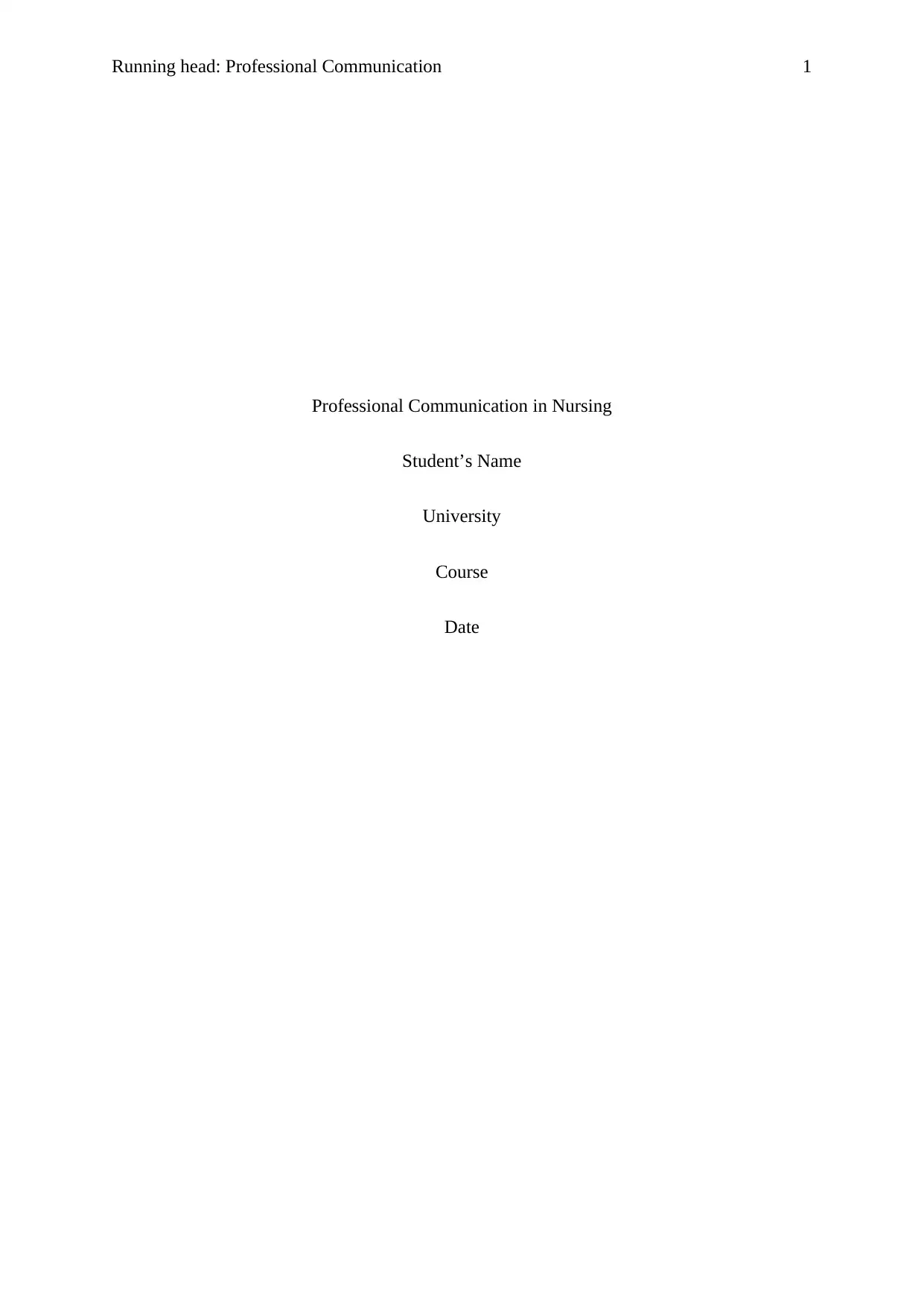
Running head: Professional Communication 1
Professional Communication in Nursing
Student’s Name
University
Course
Date
Professional Communication in Nursing
Student’s Name
University
Course
Date
Paraphrase This Document
Need a fresh take? Get an instant paraphrase of this document with our AI Paraphraser
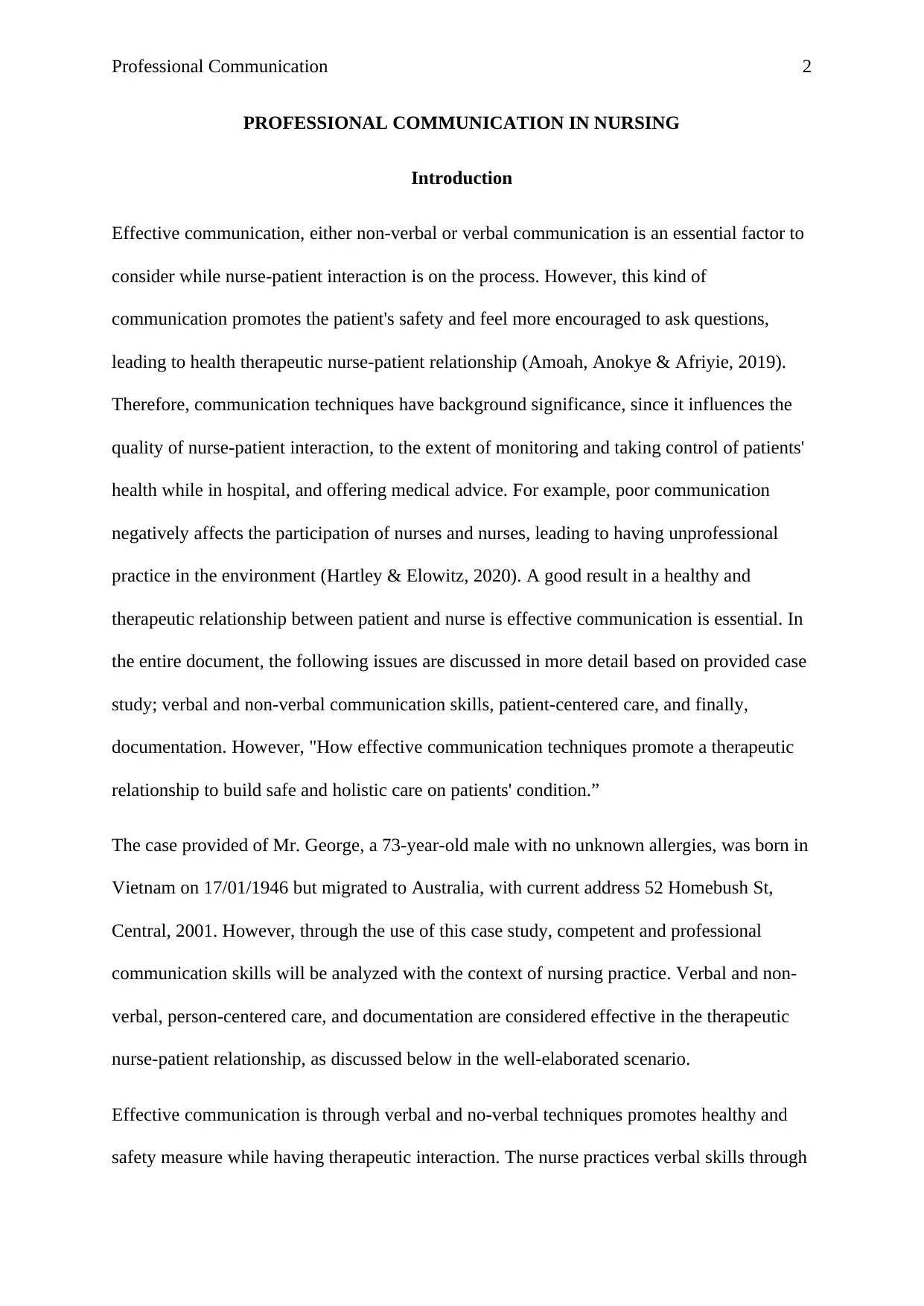
Professional Communication 2
PROFESSIONAL COMMUNICATION IN NURSING
Introduction
Effective communication, either non-verbal or verbal communication is an essential factor to
consider while nurse-patient interaction is on the process. However, this kind of
communication promotes the patient's safety and feel more encouraged to ask questions,
leading to health therapeutic nurse-patient relationship (Amoah, Anokye & Afriyie, 2019).
Therefore, communication techniques have background significance, since it influences the
quality of nurse-patient interaction, to the extent of monitoring and taking control of patients'
health while in hospital, and offering medical advice. For example, poor communication
negatively affects the participation of nurses and nurses, leading to having unprofessional
practice in the environment (Hartley & Elowitz, 2020). A good result in a healthy and
therapeutic relationship between patient and nurse is effective communication is essential. In
the entire document, the following issues are discussed in more detail based on provided case
study; verbal and non-verbal communication skills, patient-centered care, and finally,
documentation. However, "How effective communication techniques promote a therapeutic
relationship to build safe and holistic care on patients' condition.”
The case provided of Mr. George, a 73-year-old male with no unknown allergies, was born in
Vietnam on 17/01/1946 but migrated to Australia, with current address 52 Homebush St,
Central, 2001. However, through the use of this case study, competent and professional
communication skills will be analyzed with the context of nursing practice. Verbal and non-
verbal, person-centered care, and documentation are considered effective in the therapeutic
nurse-patient relationship, as discussed below in the well-elaborated scenario.
Effective communication is through verbal and no-verbal techniques promotes healthy and
safety measure while having therapeutic interaction. The nurse practices verbal skills through
PROFESSIONAL COMMUNICATION IN NURSING
Introduction
Effective communication, either non-verbal or verbal communication is an essential factor to
consider while nurse-patient interaction is on the process. However, this kind of
communication promotes the patient's safety and feel more encouraged to ask questions,
leading to health therapeutic nurse-patient relationship (Amoah, Anokye & Afriyie, 2019).
Therefore, communication techniques have background significance, since it influences the
quality of nurse-patient interaction, to the extent of monitoring and taking control of patients'
health while in hospital, and offering medical advice. For example, poor communication
negatively affects the participation of nurses and nurses, leading to having unprofessional
practice in the environment (Hartley & Elowitz, 2020). A good result in a healthy and
therapeutic relationship between patient and nurse is effective communication is essential. In
the entire document, the following issues are discussed in more detail based on provided case
study; verbal and non-verbal communication skills, patient-centered care, and finally,
documentation. However, "How effective communication techniques promote a therapeutic
relationship to build safe and holistic care on patients' condition.”
The case provided of Mr. George, a 73-year-old male with no unknown allergies, was born in
Vietnam on 17/01/1946 but migrated to Australia, with current address 52 Homebush St,
Central, 2001. However, through the use of this case study, competent and professional
communication skills will be analyzed with the context of nursing practice. Verbal and non-
verbal, person-centered care, and documentation are considered effective in the therapeutic
nurse-patient relationship, as discussed below in the well-elaborated scenario.
Effective communication is through verbal and no-verbal techniques promotes healthy and
safety measure while having therapeutic interaction. The nurse practices verbal skills through
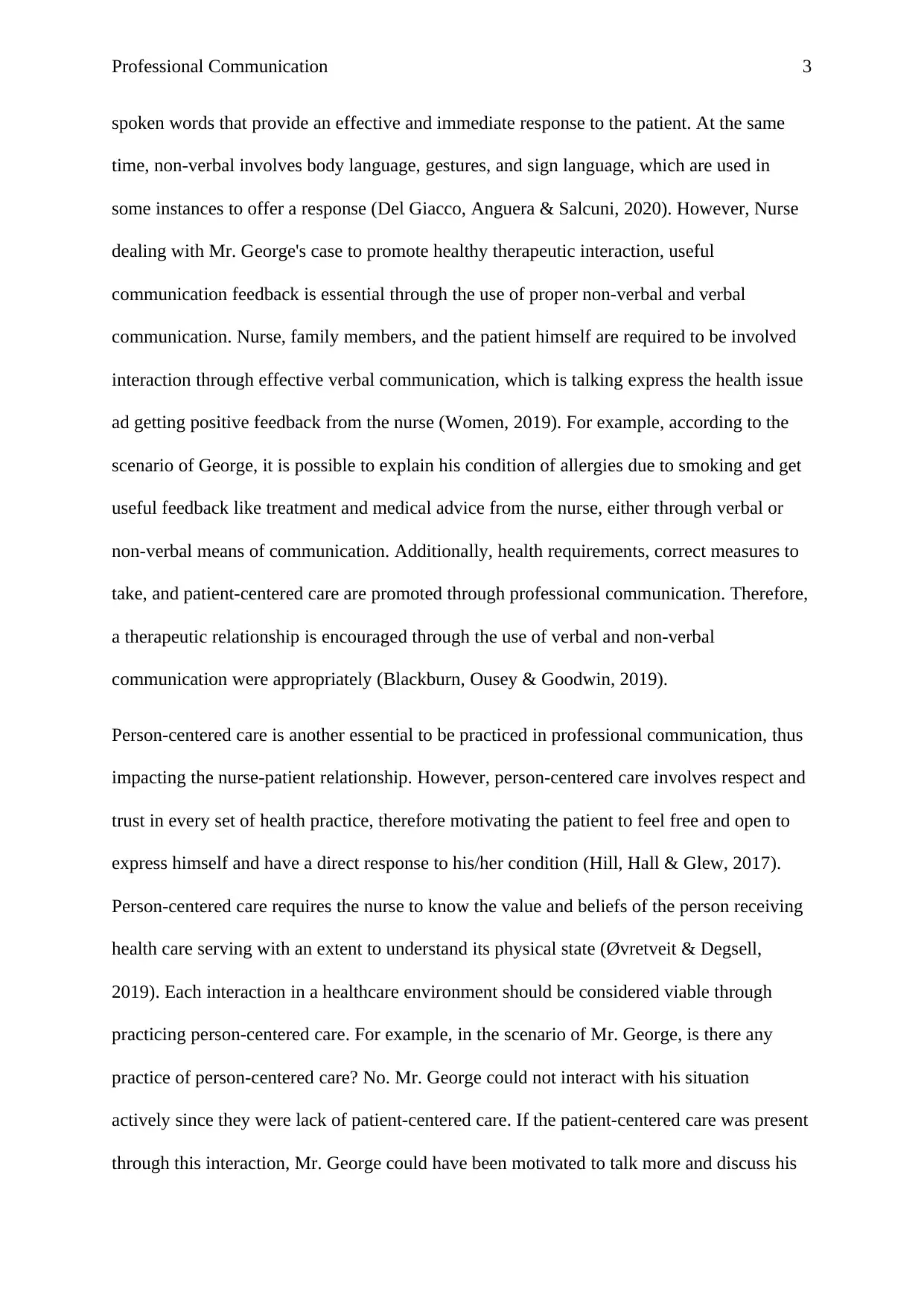
Professional Communication 3
spoken words that provide an effective and immediate response to the patient. At the same
time, non-verbal involves body language, gestures, and sign language, which are used in
some instances to offer a response (Del Giacco, Anguera & Salcuni, 2020). However, Nurse
dealing with Mr. George's case to promote healthy therapeutic interaction, useful
communication feedback is essential through the use of proper non-verbal and verbal
communication. Nurse, family members, and the patient himself are required to be involved
interaction through effective verbal communication, which is talking express the health issue
ad getting positive feedback from the nurse (Women, 2019). For example, according to the
scenario of George, it is possible to explain his condition of allergies due to smoking and get
useful feedback like treatment and medical advice from the nurse, either through verbal or
non-verbal means of communication. Additionally, health requirements, correct measures to
take, and patient-centered care are promoted through professional communication. Therefore,
a therapeutic relationship is encouraged through the use of verbal and non-verbal
communication were appropriately (Blackburn, Ousey & Goodwin, 2019).
Person-centered care is another essential to be practiced in professional communication, thus
impacting the nurse-patient relationship. However, person-centered care involves respect and
trust in every set of health practice, therefore motivating the patient to feel free and open to
express himself and have a direct response to his/her condition (Hill, Hall & Glew, 2017).
Person-centered care requires the nurse to know the value and beliefs of the person receiving
health care serving with an extent to understand its physical state (Øvretveit & Degsell,
2019). Each interaction in a healthcare environment should be considered viable through
practicing person-centered care. For example, in the scenario of Mr. George, is there any
practice of person-centered care? No. Mr. George could not interact with his situation
actively since they were lack of patient-centered care. If the patient-centered care was present
through this interaction, Mr. George could have been motivated to talk more and discuss his
spoken words that provide an effective and immediate response to the patient. At the same
time, non-verbal involves body language, gestures, and sign language, which are used in
some instances to offer a response (Del Giacco, Anguera & Salcuni, 2020). However, Nurse
dealing with Mr. George's case to promote healthy therapeutic interaction, useful
communication feedback is essential through the use of proper non-verbal and verbal
communication. Nurse, family members, and the patient himself are required to be involved
interaction through effective verbal communication, which is talking express the health issue
ad getting positive feedback from the nurse (Women, 2019). For example, according to the
scenario of George, it is possible to explain his condition of allergies due to smoking and get
useful feedback like treatment and medical advice from the nurse, either through verbal or
non-verbal means of communication. Additionally, health requirements, correct measures to
take, and patient-centered care are promoted through professional communication. Therefore,
a therapeutic relationship is encouraged through the use of verbal and non-verbal
communication were appropriately (Blackburn, Ousey & Goodwin, 2019).
Person-centered care is another essential to be practiced in professional communication, thus
impacting the nurse-patient relationship. However, person-centered care involves respect and
trust in every set of health practice, therefore motivating the patient to feel free and open to
express himself and have a direct response to his/her condition (Hill, Hall & Glew, 2017).
Person-centered care requires the nurse to know the value and beliefs of the person receiving
health care serving with an extent to understand its physical state (Øvretveit & Degsell,
2019). Each interaction in a healthcare environment should be considered viable through
practicing person-centered care. For example, in the scenario of Mr. George, is there any
practice of person-centered care? No. Mr. George could not interact with his situation
actively since they were lack of patient-centered care. If the patient-centered care was present
through this interaction, Mr. George could have been motivated to talk more and discuss his
⊘ This is a preview!⊘
Do you want full access?
Subscribe today to unlock all pages.

Trusted by 1+ million students worldwide
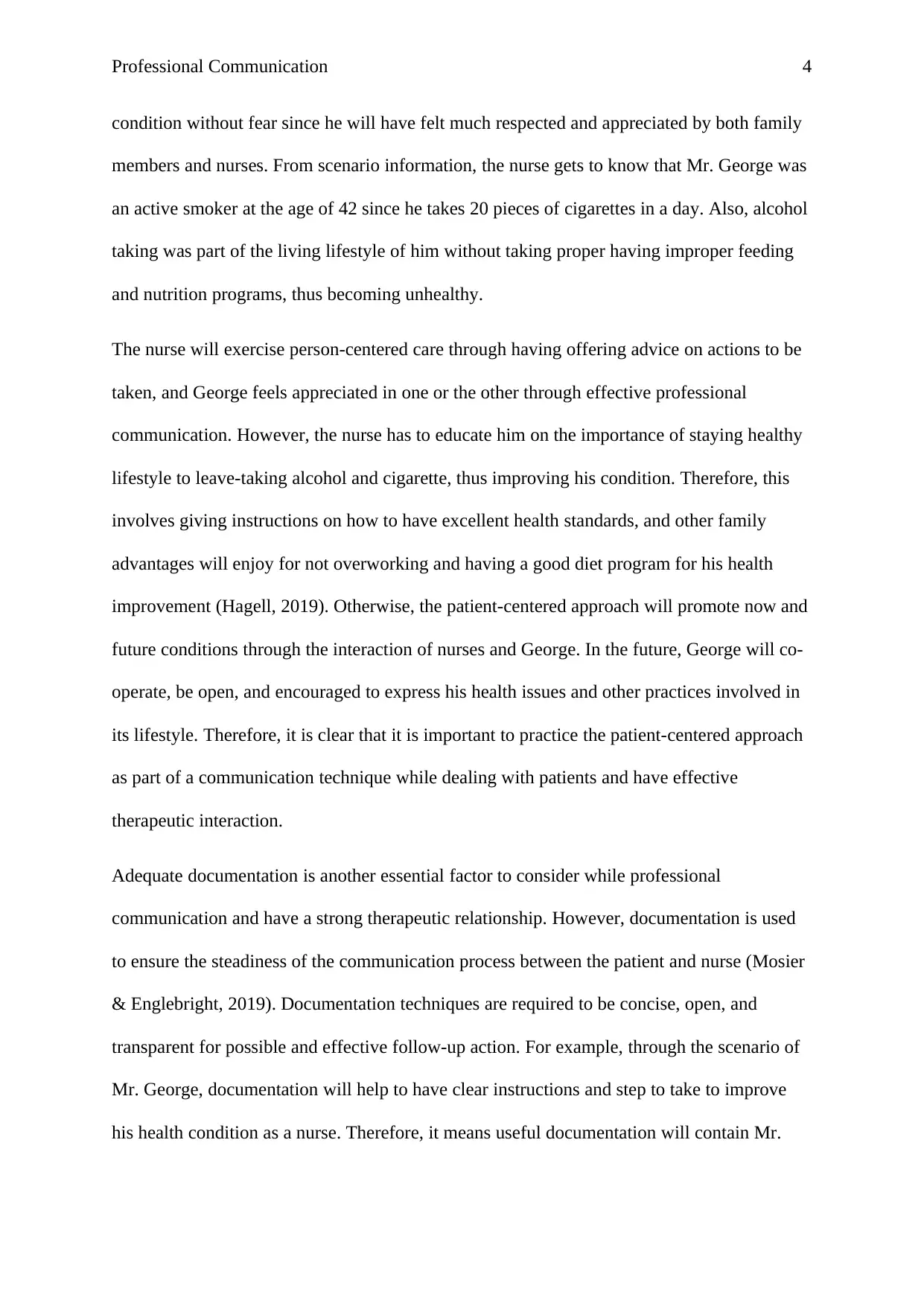
Professional Communication 4
condition without fear since he will have felt much respected and appreciated by both family
members and nurses. From scenario information, the nurse gets to know that Mr. George was
an active smoker at the age of 42 since he takes 20 pieces of cigarettes in a day. Also, alcohol
taking was part of the living lifestyle of him without taking proper having improper feeding
and nutrition programs, thus becoming unhealthy.
The nurse will exercise person-centered care through having offering advice on actions to be
taken, and George feels appreciated in one or the other through effective professional
communication. However, the nurse has to educate him on the importance of staying healthy
lifestyle to leave-taking alcohol and cigarette, thus improving his condition. Therefore, this
involves giving instructions on how to have excellent health standards, and other family
advantages will enjoy for not overworking and having a good diet program for his health
improvement (Hagell, 2019). Otherwise, the patient-centered approach will promote now and
future conditions through the interaction of nurses and George. In the future, George will co-
operate, be open, and encouraged to express his health issues and other practices involved in
its lifestyle. Therefore, it is clear that it is important to practice the patient-centered approach
as part of a communication technique while dealing with patients and have effective
therapeutic interaction.
Adequate documentation is another essential factor to consider while professional
communication and have a strong therapeutic relationship. However, documentation is used
to ensure the steadiness of the communication process between the patient and nurse (Mosier
& Englebright, 2019). Documentation techniques are required to be concise, open, and
transparent for possible and effective follow-up action. For example, through the scenario of
Mr. George, documentation will help to have clear instructions and step to take to improve
his health condition as a nurse. Therefore, it means useful documentation will contain Mr.
condition without fear since he will have felt much respected and appreciated by both family
members and nurses. From scenario information, the nurse gets to know that Mr. George was
an active smoker at the age of 42 since he takes 20 pieces of cigarettes in a day. Also, alcohol
taking was part of the living lifestyle of him without taking proper having improper feeding
and nutrition programs, thus becoming unhealthy.
The nurse will exercise person-centered care through having offering advice on actions to be
taken, and George feels appreciated in one or the other through effective professional
communication. However, the nurse has to educate him on the importance of staying healthy
lifestyle to leave-taking alcohol and cigarette, thus improving his condition. Therefore, this
involves giving instructions on how to have excellent health standards, and other family
advantages will enjoy for not overworking and having a good diet program for his health
improvement (Hagell, 2019). Otherwise, the patient-centered approach will promote now and
future conditions through the interaction of nurses and George. In the future, George will co-
operate, be open, and encouraged to express his health issues and other practices involved in
its lifestyle. Therefore, it is clear that it is important to practice the patient-centered approach
as part of a communication technique while dealing with patients and have effective
therapeutic interaction.
Adequate documentation is another essential factor to consider while professional
communication and have a strong therapeutic relationship. However, documentation is used
to ensure the steadiness of the communication process between the patient and nurse (Mosier
& Englebright, 2019). Documentation techniques are required to be concise, open, and
transparent for possible and effective follow-up action. For example, through the scenario of
Mr. George, documentation will help to have clear instructions and step to take to improve
his health condition as a nurse. Therefore, it means useful documentation will contain Mr.
Paraphrase This Document
Need a fresh take? Get an instant paraphrase of this document with our AI Paraphraser
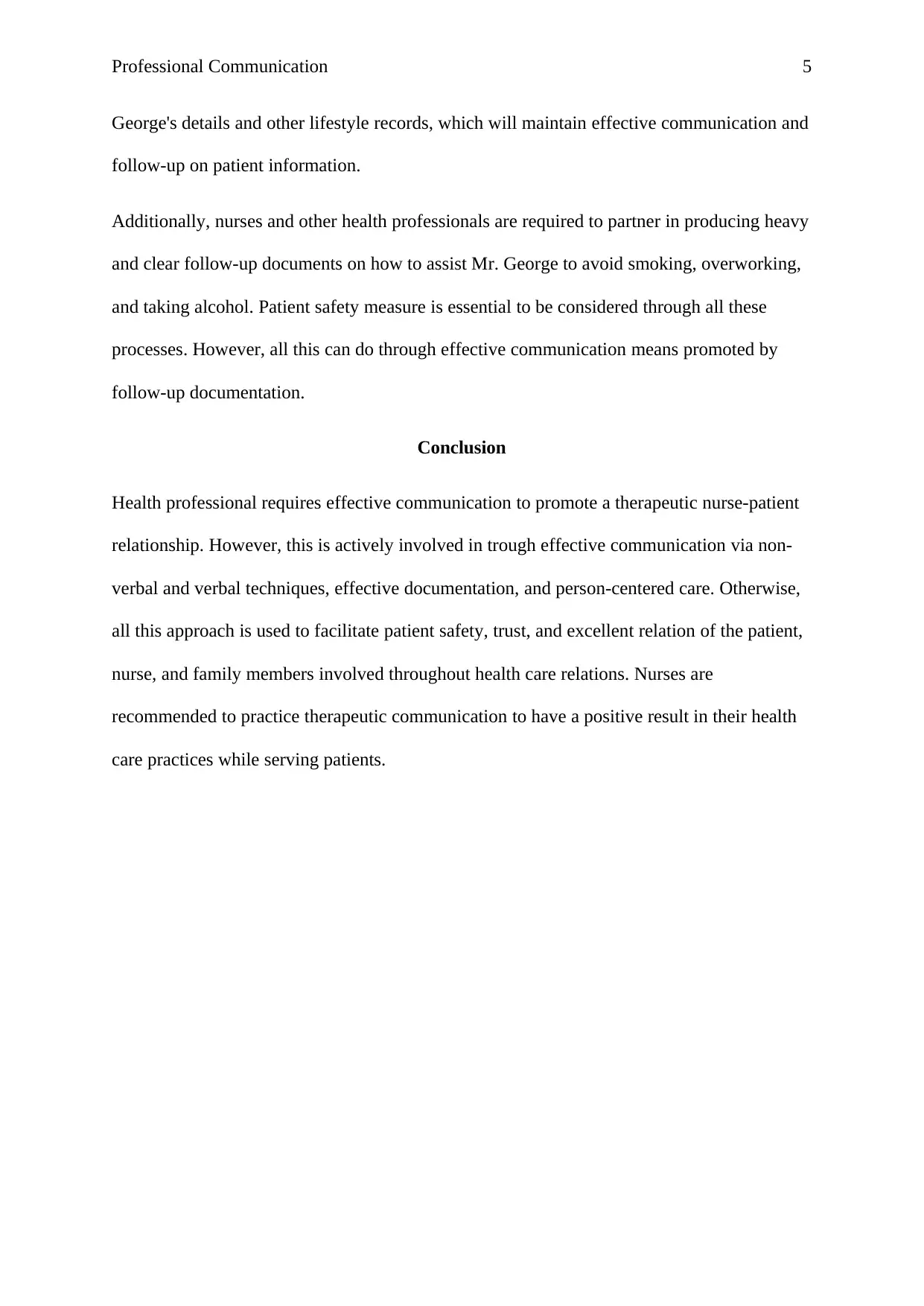
Professional Communication 5
George's details and other lifestyle records, which will maintain effective communication and
follow-up on patient information.
Additionally, nurses and other health professionals are required to partner in producing heavy
and clear follow-up documents on how to assist Mr. George to avoid smoking, overworking,
and taking alcohol. Patient safety measure is essential to be considered through all these
processes. However, all this can do through effective communication means promoted by
follow-up documentation.
Conclusion
Health professional requires effective communication to promote a therapeutic nurse-patient
relationship. However, this is actively involved in trough effective communication via non-
verbal and verbal techniques, effective documentation, and person-centered care. Otherwise,
all this approach is used to facilitate patient safety, trust, and excellent relation of the patient,
nurse, and family members involved throughout health care relations. Nurses are
recommended to practice therapeutic communication to have a positive result in their health
care practices while serving patients.
George's details and other lifestyle records, which will maintain effective communication and
follow-up on patient information.
Additionally, nurses and other health professionals are required to partner in producing heavy
and clear follow-up documents on how to assist Mr. George to avoid smoking, overworking,
and taking alcohol. Patient safety measure is essential to be considered through all these
processes. However, all this can do through effective communication means promoted by
follow-up documentation.
Conclusion
Health professional requires effective communication to promote a therapeutic nurse-patient
relationship. However, this is actively involved in trough effective communication via non-
verbal and verbal techniques, effective documentation, and person-centered care. Otherwise,
all this approach is used to facilitate patient safety, trust, and excellent relation of the patient,
nurse, and family members involved throughout health care relations. Nurses are
recommended to practice therapeutic communication to have a positive result in their health
care practices while serving patients.
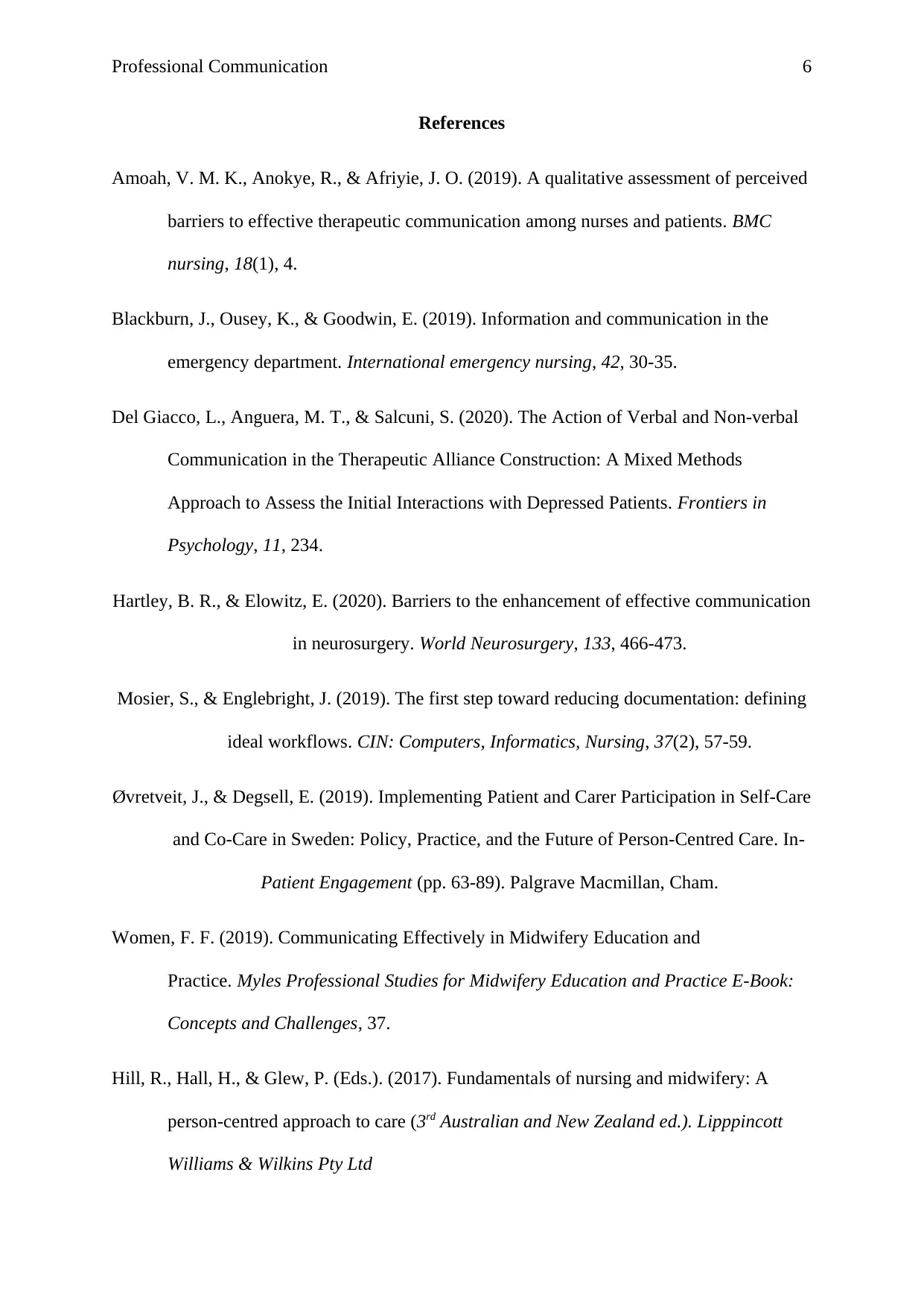
Professional Communication 6
References
Amoah, V. M. K., Anokye, R., & Afriyie, J. O. (2019). A qualitative assessment of perceived
barriers to effective therapeutic communication among nurses and patients. BMC
nursing, 18(1), 4.
Blackburn, J., Ousey, K., & Goodwin, E. (2019). Information and communication in the
emergency department. International emergency nursing, 42, 30-35.
Del Giacco, L., Anguera, M. T., & Salcuni, S. (2020). The Action of Verbal and Non-verbal
Communication in the Therapeutic Alliance Construction: A Mixed Methods
Approach to Assess the Initial Interactions with Depressed Patients. Frontiers in
Psychology, 11, 234.
Hartley, B. R., & Elowitz, E. (2020). Barriers to the enhancement of effective communication
in neurosurgery. World Neurosurgery, 133, 466-473.
Mosier, S., & Englebright, J. (2019). The first step toward reducing documentation: defining
ideal workflows. CIN: Computers, Informatics, Nursing, 37(2), 57-59.
Øvretveit, J., & Degsell, E. (2019). Implementing Patient and Carer Participation in Self-Care
and Co-Care in Sweden: Policy, Practice, and the Future of Person-Centred Care. In-
Patient Engagement (pp. 63-89). Palgrave Macmillan, Cham.
Women, F. F. (2019). Communicating Effectively in Midwifery Education and
Practice. Myles Professional Studies for Midwifery Education and Practice E-Book:
Concepts and Challenges, 37.
Hill, R., Hall, H., & Glew, P. (Eds.). (2017). Fundamentals of nursing and midwifery: A
person-centred approach to care (3rd Australian and New Zealand ed.). Lipppincott
Williams & Wilkins Pty Ltd
References
Amoah, V. M. K., Anokye, R., & Afriyie, J. O. (2019). A qualitative assessment of perceived
barriers to effective therapeutic communication among nurses and patients. BMC
nursing, 18(1), 4.
Blackburn, J., Ousey, K., & Goodwin, E. (2019). Information and communication in the
emergency department. International emergency nursing, 42, 30-35.
Del Giacco, L., Anguera, M. T., & Salcuni, S. (2020). The Action of Verbal and Non-verbal
Communication in the Therapeutic Alliance Construction: A Mixed Methods
Approach to Assess the Initial Interactions with Depressed Patients. Frontiers in
Psychology, 11, 234.
Hartley, B. R., & Elowitz, E. (2020). Barriers to the enhancement of effective communication
in neurosurgery. World Neurosurgery, 133, 466-473.
Mosier, S., & Englebright, J. (2019). The first step toward reducing documentation: defining
ideal workflows. CIN: Computers, Informatics, Nursing, 37(2), 57-59.
Øvretveit, J., & Degsell, E. (2019). Implementing Patient and Carer Participation in Self-Care
and Co-Care in Sweden: Policy, Practice, and the Future of Person-Centred Care. In-
Patient Engagement (pp. 63-89). Palgrave Macmillan, Cham.
Women, F. F. (2019). Communicating Effectively in Midwifery Education and
Practice. Myles Professional Studies for Midwifery Education and Practice E-Book:
Concepts and Challenges, 37.
Hill, R., Hall, H., & Glew, P. (Eds.). (2017). Fundamentals of nursing and midwifery: A
person-centred approach to care (3rd Australian and New Zealand ed.). Lipppincott
Williams & Wilkins Pty Ltd
⊘ This is a preview!⊘
Do you want full access?
Subscribe today to unlock all pages.

Trusted by 1+ million students worldwide
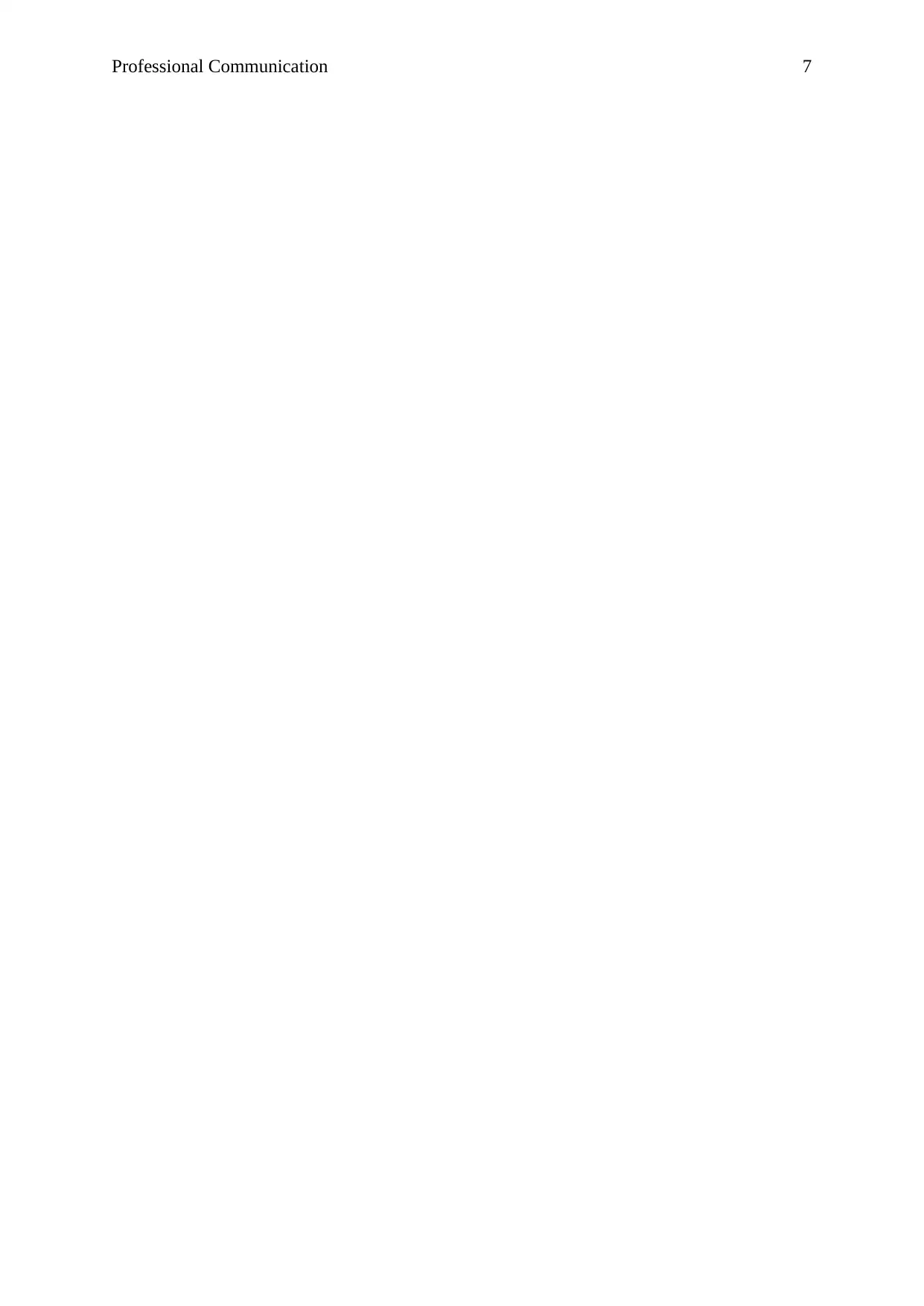
Professional Communication 7
1 out of 7
Related Documents
Your All-in-One AI-Powered Toolkit for Academic Success.
+13062052269
info@desklib.com
Available 24*7 on WhatsApp / Email
![[object Object]](/_next/static/media/star-bottom.7253800d.svg)
Unlock your academic potential
Copyright © 2020–2025 A2Z Services. All Rights Reserved. Developed and managed by ZUCOL.





